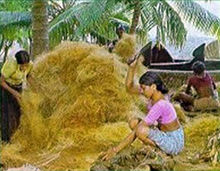This article has multiple issues. Please help improve it or discuss these issues on the talk page. (Learn how and when to remove these messages)
|


Coir (/ˈkɔɪər/), also called coconut fibre, is a natural fibre extracted from the outer husk of coconut,[1] and used in products such as floor mats, doormats, brushes, and mattresses. Coir is the fibrous material found between the hard, internal shell and the outer coat of a coconut. Other uses of brown coir (made from ripe coconut) are in upholstery padding, sacking and horticulture. White coir, harvested from unripe coconuts, is used for making finer brushes, string, rope and fishing nets.[2][3] It has the advantage of not sinking, so can be used in long lengths in deep water without the added weight dragging down boats and buoys.
Coir must not be confused with coir pith, which is the powdery and spongy material resulting from the processing of the coir fibre.[4] Coir fibre is locally named 'coprah' in some countries, adding to confusion. Pith is chemically similar to coir, but contains much shorter fibers.[5] The name coco peat may refer either to coir or the pith or a mixture, as both have good water-retaining properties as a substitute for peat.[6]
- ^ Chisholm, Hugh, ed. (1911). . Encyclopædia Britannica. Vol. 6 (11th ed.). Cambridge University Press. p. 654.
- ^ How coir is made - material, making, history, used, processing, product, industry, machine, History Archived 2006-07-14 at the Wayback Machine
- ^ "Coco Coir - 7 Things Every Gardener Should Know". DIY Gardening. Retrieved 20 October 2023.
- ^ "Coir Pith | Coirboard".
- ^ Narendar, R.; Priya Dasan, K. (2014). "Chemical treatments of coir pith: Morphology, chemical composition, thermal and water retention behavior". Composites Part B: Engineering. 56: 770–779. doi:10.1016/j.compositesb.2013.09.028.
- ^ Cite error: The named reference
madehowwas invoked but never defined (see the help page).